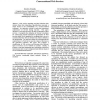AIPS
2010
14 years 1 months ago
2010
We present Shopper, a plan execution engine that facilitates experimental evaluation of plans and makes it easier for planning researchers to incorporate replanning. Shopper inter...
ECOWS
2009
Springer
14 years 2 months ago
2009
Springer
— Web services exposing run-time behaviour that deviates from their behavioural specifications represent a major threat to the sustainability of a service-oriented ecosystem. It ...
ESWS
2010
Springer
14 years 3 months ago
2010
Springer
Service orientation is a promising paradigm for offering and consuming functionalities within and across organizations. Ever increasing acceptance of service oriented architecture...
ESWS
2006
Springer
14 years 3 months ago
2006
Springer
The Web Service Modeling Language (WSML) is a language for the specification of different aspects of Semantic Web Services. It provides a formal language for the Web Service Modeli...
ECOWS
2006
Springer
14 years 3 months ago
2006
Springer
This paper is about Web services used in distributed, inter-organizational business cooperation (choreography). In this application scenario, we have a multipart functional conven...
ECOWS
2006
Springer
14 years 3 months ago
2006
Springer
Measurement of semantic similarity between Web services is an important factor for Web service discovery, composition, and even execution. Semantic Web services (SWS) are usually ...
DEXA
2006
Springer
14 years 3 months ago
2006
Springer
The Business Process Execution Language BPEL4WS has emerged to introduce process dimension in Web Services coordination. At the same time, a lot of needs related to business proces...
COORDINATION
2006
Springer
14 years 3 months ago
2006
Springer
We tackle the problem of providing rigorous formal foundations to current software engineering technologies for web services. We focus on two of the most used XML-based languages f...
EUROMICRO
2004
IEEE
14 years 3 months ago
2004
IEEE
We illustrate a symbiotic relationship between existing model oriented specification techniques and web services. Through the formal re-design of a platform for mobile team collab...
EDOC
2004
IEEE
14 years 3 months ago
2004
IEEE
Modeling is a technique used extensively in industry to define software systems, the UML being the most prominent example. With the increased use of modeling techniques has come t...

